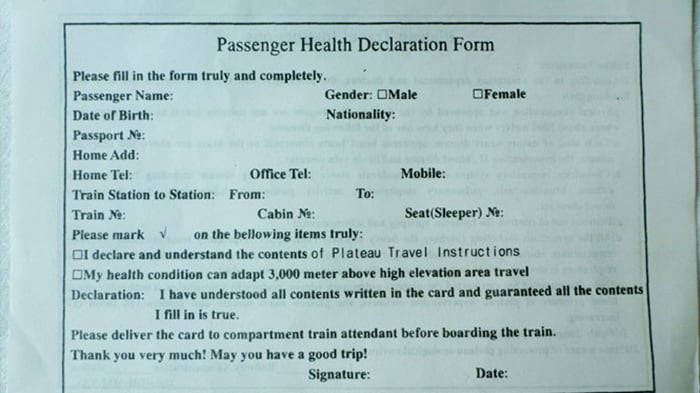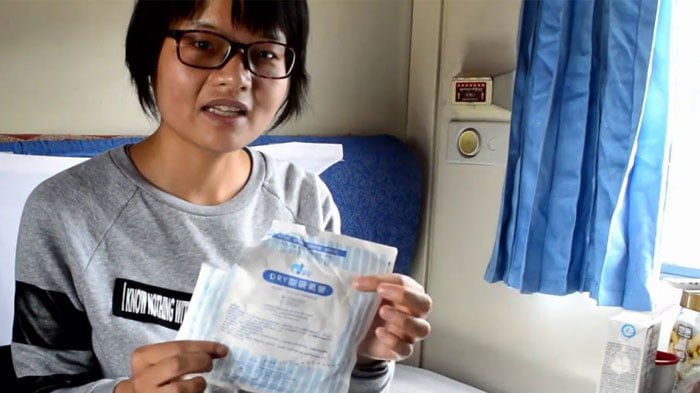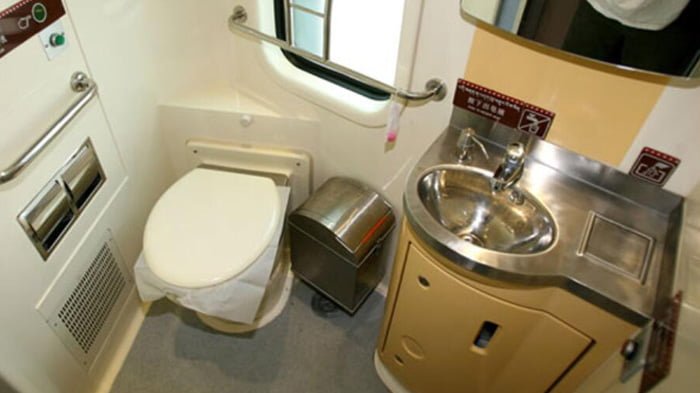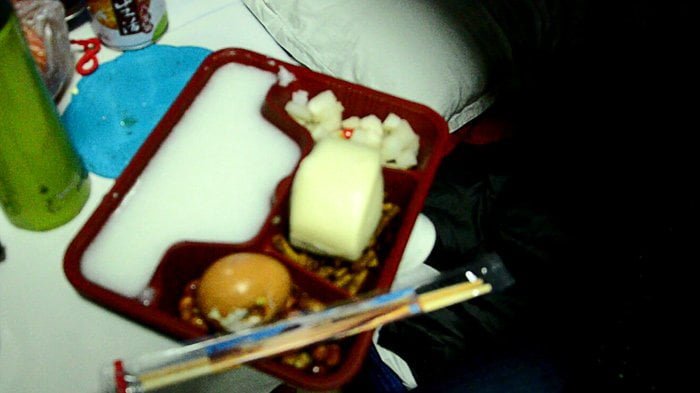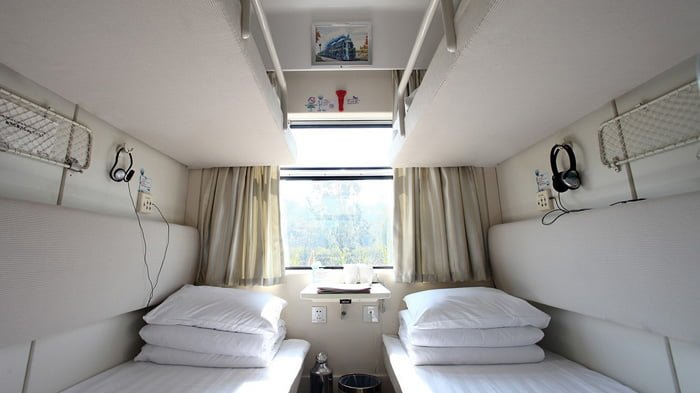Though there are trains bound for Lhasa from Beijing, Shanghai, and Chengdu, the genuine Qinghai-Tibet Train Z6801 starts from Xining, Qinghai Province with 1,956 kilometers in total. It takes approximately one day (or 21:19 hour ride) from Xining to Lhasa. Each year there are around one-quarter of tourists who may take trains to Lhasa from Xining.
Xining is the capital of Qinghai Province in western China and the largest city on the Tibetan Plateau. The city was a commercial hub along the Northern Silk Road’s Hexi Corridor for over 2000 years and was a stronghold of the Han, Sui, Tang, and Song dynasties’ resistance against nomadic attacks from the west. Xining holds sites of religious significance to Muslims and Buddhists, including the Dongguan Mosque and Ta’er Monastery.
Should I Choose Soft Sleeper or Hard Sleeper?
Each train to Tibet consists of two first-class sleeper (soft sleeper) carriages, eight second-class sleeper (hard sleeper) carriages, four seat carriages, one dining carriage and one generator carriage.
Why Soft Sleeper is Better than Hard Sleeper?
Like each Lhasa-bound train, the train to Lhasa from Xining is also especially built for the high altitude environment and equipped with advanced facilities, such as air-conditioning, supercharging system, oxygen supply, altitude display, etc. The train is also tightly sealed so as to firstly keep the inside air pressure normal and secondly prevent passengers from littering. Besides, all the carriages are installed with double-pane windows and ultraviolet filters to protect passengers from ultraviolet radiation. Nowadays, the train journey is extremely popular for its breathtakingly unique scenery along the railway from Xining to Tibet.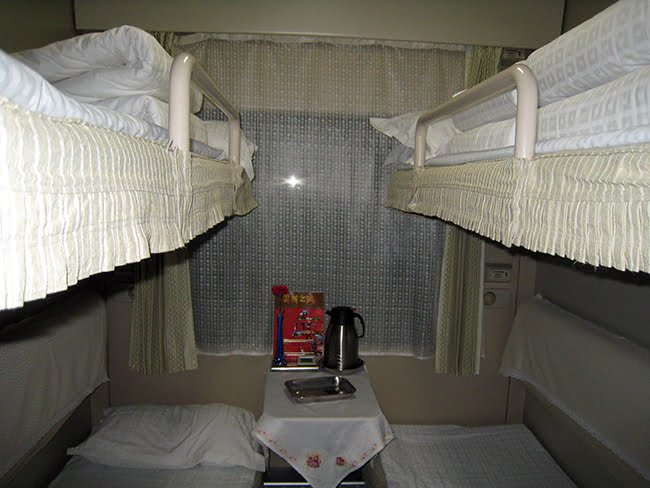
The comfortable and spacious soft sleeper is helpful for a night of sound sleep
In fact, there are three kinds of accommodations available on Xining-Lhasa train: soft sleeper, hard sleeper, and hard seat, of which the most comfortable one is the soft sleeper. The soft sleeper consists of 4 bunks (75cm*190cm) and promises more privacy and comfort with a sliding lockable door, which is highly recommended.
While the hard sleeper is made up of 6 bunks (60cm*180cm) and the living space varies slightly. The lowest bunks enjoy the largest living space whereas the top bunks are cramped. The cabin of a hard sleeper has no independent door to close when tourists want to sleep. Hard seat is not recommended given the long ride and nothing is more important than having a sound sleep.
Xining-Lhasa Train Schedule
| Train Number | Departure | Arrival | Duration | Distance | Frequency | Ticket Price | |
|---|---|---|---|---|---|---|---|
| Z323 (Chengdu-Lhasa) | 12:26 | 9:55 | 21:29hrs | 1,956km | Every other day | ¥495.00 Hard sleeper | ¥781.00 Soft sleeper |
| Z223 (Chongqing-Lhasa) | 12:26 | 9:55 | 21:29hrs | 1,956km | Every other day | ¥495.00 Hard sleeper | ¥781.00 Soft sleeper |
| Z6801 (Xining-Lhasa original) | 14:01 | 11:20 | 21:19hrs | 1,956km | Every other day | ¥495.00 Hard sleeper | ¥781.00 Soft sleeper |
| Z917 (Lanzhou-Lhasa) | 14:01 | 11:20 | 21:19hrs | 1,956km | Every other day | ¥495.00 Hard sleeper | ¥781.00 Soft sleeper |
| Z21 (Beijing-Lhasa) | 15:21 | 12:45 | 21:24hrs | 1,956km | Daily | ¥495.00 Hard sleeper | ¥781.00 Soft sleeper |
| Z9813 (Xining-Lhasa original) | 16:40 | 14:10 | 21:30hrs | 1,956km | Seasonal | ¥495.00 Hard sleeper | ¥781.00 Soft sleeper |
| Z265 (Guangzhou-Lhasa) | 19:31 | 16:45 | 21:14hrs | 1,956km | Daily | ¥495.00 Hard sleeper | ¥781.00 Soft sleeper |
| Z165 (Shanghai-Lhasa) | 21:27 | 19:35 | 22:08hrs | 1,956km | Daily | ¥495.00 Hard sleeper | ¥781.00 Soft sleeper |
| Z9815 (Xining-Lhasa original) | 23:02 | 21:00 | 21:58hrs | 1,956km | Seasonal | ¥495.00 Hard sleeper | ¥781.00 Soft sleeper |
Basically, there are 9 trains bound for Lhasa. Yet, there are only 3 trains that start directly from Xining to Lhasa, i.e. Z6801, Z9813 and Z9815. Z6801 originally departs every other day at 14:01 from Xining Railway Station and arrives in Lhasa at 11:20 next day, taking 21:19 hours to cross the 1,956 kilometer between the Qinghai-Tibet Railway. Besides, the Z9813 and Z9815 are the seasonal trains running to meet the high demands of summer tourists at home and abroad (updated at Sept. 3rd, 2019).
For better scenery, Tibet Vista recommends tourists taking Z9815, Z165 and Z265 because tourists can board the train and sleep on the train. The next day as tourists open their eyes, the train is exactly crossing Golmud, and tourists can enjoy Qarhan Salt Lake, the largest salt lake in China and endless grotesquely-shaped salt flowers and unusual salt lake surroundings. In addition, as the initial station of Z265 is Guangzhou, the train itself should be comparatively less crowded.
To get train tickets much easier, Tibet Vista suggests tourists taking trains like Z6801, Z9813, Z9815, Z265 and Z917. Yet. There is no guarantee in summer when Tibet tourism reaches its peak season.
Why We Recommend Xining-Lhasa Trains instead of Lhasa Trains from Other Gateway Cities
For the sake of a better Tibet train journey, we recommend tourists to take the train to Tibet from Xining. The benefits of Xining-Lhasa train route are as followings:
Quickest Railway Access to Lhasa Xining is the initial train station of Qinghai-Tibet train closest to Lhasa. The entire train ride only takes one day and tourists get on the train and the next day they will be on Qinghai-Tibet Plateau, enjoying the breathtaking scenery through the window of the train.
Highest Transportation Capacity There are over 3 trains bound for Lhasa from Xining each day, bringing more than a thousand tourists to Lhasa on a daily basis. Its transportation capacity is three times than that of Beijing-Lhasa or Shanghai-Lhasa train. The peak season of Qinghai-Tibet train comes in summer. At that time, the train ticket could be hard to buy. Yet, if tourists can start their journey from Xining instead of Beijing or Shanghai to Lhasa, it can be much easier to buy Qinghai-Tibet train tickets.
Best City to Acclimatize High Plateau Situated at 2,275 meters above sea level, Xining is the ideal city for travelers to acclimatize to the high plateau compared with other gateway cities such as Beijing (44m) and Chengdu (500m). Tourists can stay in Xining for around 2 days to adapt to the elevation and have a good rest before heading for Tibet.
Most Important City of Qinghai Provice Of course, you can choose to stay in Xining for a couple of days and travel in Xining. Xining is a well-known city in Tibetan region. Xining has many attractions such as Kumbum Monastery, the birthplace of the founder of Buddhism-Lama Tsongkhapa (one of the six prestigious monasteries in Tibet) and Qinghai Lake, the largest inland lake.
Alternative Plan When You Failed to Get Train Tickets from Gateway Cities
The peak travel season of Qinghai-Tibet Railway normally comes during the summer holiday (July – August). By then, the demand for soft sleeper tickets will far exceed the actual supply, approximately over 1000% as it can offer. Sadly, railway stations in gateway cities can’t meet the needs at all.
Take Beijing West Railway Station for example, it can only meet 10% of tourists’ needs. To secure your travel, we suggest a viable alternative plan: instead of taking non-stop train from Beijing to Lhasa, you can fly from Beijing to Xining (or Lanzhou) and then get train ticket from Xining (or Lanzhou) to Lhasa. The alternative Beijing-Lhasa travel route makes sense in three aspects:
a. It can shorten tourists’ time on the train because it only takes 21 hours from Xining to Lhasa. Tourists can save 20hours of long and tiring train journey, roughly half way of Beijing-Lhasa train route. And then you continue to head to Lhasa from Xining Railway Station, the essence and beginning of the Qinghai-Tibet Railway.
b. It can secure your train journey. There are many trains departing from Xining to Lhasa. As a result, it can ensure that visitors will be able to get onboard successfully and can minimize the risk of failing to buy ticket from Beijing.
c. The trains bound to Lhasa from Xining normally start from late afternoon. It enables visitors to have a longer time to enjoy the scenery from Golmud to Lhasa. Otherwise, if one departs from Beijing, he or she only has several hours to enjoy the scenery, because the time train arrives in Golmud is at night, at around 22:10.
Tips: If the original plan of buying non-stop train from Beijing is insisted, Tibet Vista cannot ensure 100% of buying the ticket because of the shortage of Beijing-Lhasa train tickets from Beijing West Railway Station. As a result, you may face changing date or degrading to hard sleeping berth, even fail to travel to Tibet. Therefore, the above alternative plan is highly recommended and workable during high season. We feel very sorry for the extra 250 US dollars. Hopefully, you can accept our suggestion and choose a more secured way of travel.
How to Book and Get Tibet Train Tickets?
International travelers can’t enter in Tibet as backpackers and need the help of travel agency to apply for Tibet Travel Permit in advance. You do not need the permit to book the tickets but you do need it to board the train.
1. How to Book Tibet Train Ticket?
Book train ticket with us ( highly recommended) To individual tourists, the best solution is to contact a reliable travel agency and book the Xining-Lhasa train ticket at least one month in advance. Tibet Vista can provide such timely tickets booking service, and also offer “Train Ticket + Tibet Tour” packages. Send a detailed booking inquiry to Tibet Vista
Book at 12306.cn or buy ticket at train station Neither method is convenient for international travelers. The 12306.cn has no English version and the online payment is limited to Chinese bank card, Wechat Pay and Alipay. The staff in train station can’t speak English. For popular route such as Xining to Lhasa train, during the peak season and even the off season of Tibet tourism, it is difficult for foreign tourists to book train tickets.
2. How to Get the Tibet Train Ticket?
In China, you need the paper train tickets to get into your train. If you book train tickets with us, you have two ways to get your paper tickets: 1. We deliver the paper tickets to your hotel or address in China (Recommended) 2. Collect them at the railway station
If you choose the delivery service, it is advisable to inform us 4 business days before departure. If you choose to collect them at the railway station, make sure to bring the confirmation number of train tickets, your Tibet Travel Permit as well as your valid and original passport. The confirmation number will be sent to you along with related train information once the tickets are confirmed, present it and the mentioned documents to the staff behind ticket windows to get paper tickets for free.
Xining Railway Station operates 24/7, but usually there are only a few ticket windows available after 11 p.m. Considering the long queues in front of the ticket window and the language barrier, it is advisable to arrive at the train station at least 2 hours before departure if you collect tickets on the same day.
Notice: Tibet Travel Permit is needed for collecting the Tibet train ticket. We will help you get the Tibet permit in advance.
3. How to Read the Train Ticket
Here are some useful phrases you may need to read the Z6801 Xining-Lhasa train ticket:
西宁站:Xining Railway Station
拉萨站: Lhasa Railway Station
xx年xx月xx日: xx Year xx Month xx Date
xx车xx号: xx Carriage xx Berth
上/ 中/ 下铺:Upper/ Middle/ Lower Berth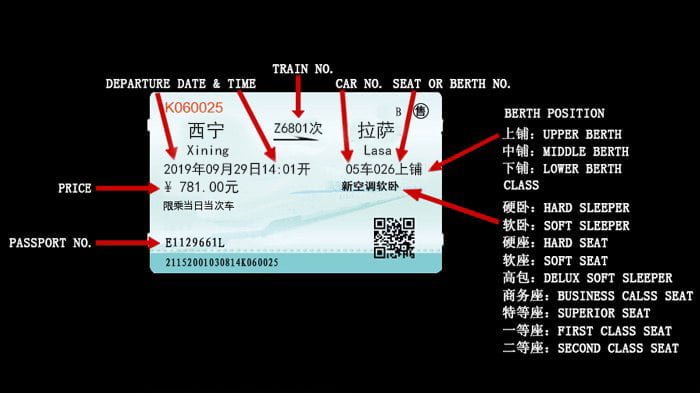
Information guide on Xining to Tibet Train Ticket
How to Board the Train?
Xining Railway Station is a hub of great importance connecting Qinghai-Tibet train, sending more than half of passengers who use the Qinghai-Tibet railway. Passengers used to get on Xining-Tibet trains at Xining West Railway Station. However, from the end of 2014, Xining Railway Station becomes the only train station serving all the trains from and to Tibet. Below are the steps to board a train in China:
Step1: Fill in the Health History Form Before boarding the train, tourists are expected to fill out an health history form. If one has illness such as hypertension, stroke, chronic respiratory problem, and other cardiovascular disease, he or she shall no board the train for one’s health concern.
Step2: Pass Security Check After your arriving at the right railway station, line up for the security check to enter into waiting hall: present your passport, Tibet Travel Permit and train ticket to the staff, put all your luggage such backpacks, carry-on bags on the security scanner conveyor belt, and walk through a detector gate and wait for staff to use a scanner on you to check forbidden articles.
Notice: Tourists should put your luggage to the X-Ray scanner and things like gun, poison, explosive, and chemical substance, etc are strictly forbidden.
Step3: Find the Waiting Room Once enter into the waiting hall of Xining Railway Station, you can find an LED screen showing Train Number (车次), Terminal (终到站), Departing Time (开点) and Waiting Room (候车室). Get your waiting room information and wait for check-in there. The train number is well marked in the correct waiting room.
Step4: Board the Train Usually check-in starts 15-30 minutes before departure and barriers close 5 minutes before departure. After check-in, you can find Led screen hang on the way to the train telling your platform (站台) and direction of your carriage (车厢). Follow the instruction and the staff waiting at the carriage gate will check your ticket again to make sure you board the right carriage of the right train.
Step5: Find Your Berth After getting on the train, you can find your berth according to your ticket. Put your baggage on the rack overhead or under the lower berth. Your sleeper ticket will be exchanged for a plastic berth card by staff shortly after boarding. Staff will return your ticket and get back the berth card about half an hour before arriving at your destination.
FAQs:
Q1. Is it necessary to carry Tibet Travel Permit all the time? Make sure you have your passport, Tibet Travel Permit and ticket with you as you could be checked many times during the long journey. It is also advisable to have many copies of Tibet Travel Permit.
Q2. Is it possible to swap ticket with other people to stay with friends or family in the same cabin? Yes. It is acceptable. You may ask conductor to swap tickets with other passengers to stay with your family or friends. Do remember your cabin and seat No.
Q3. Is It Safe on the Tibet Train? Having a ride on Qinghai-Tibet train is relatively safe as each compartment is independent and its door will automatically be closed at night. One is forbidden to enter the compartment without ticket. Of course, nowhere is safer than the compartments of soft sleeper. The cabin of soft sleeper can accommodate 4 travellers and there is a door to shut, which is the perfect choice for a family. Besides, the surveillance cameras and 24-hours police patrol make it even safer on the train.
Life Onboard
In order to ensure that the trains run on the high plateau safely, and that passengers travel on-board comfortably, Xining to Lhasa Train is well-designed taking into account the conditions faced: high elevation, low temperature, lack of oxygen, harsh climate, etc. In a word, the trains to Tibet are pressurized like aircraft and are the best in China.
1. Food and Drinks
Before the departure from Xining Railway Station, do bring enough food. It could be snacks, fruit and instant noodles wrapped in bowls. Sharing snack with roommates is the easiest way to break the silence. 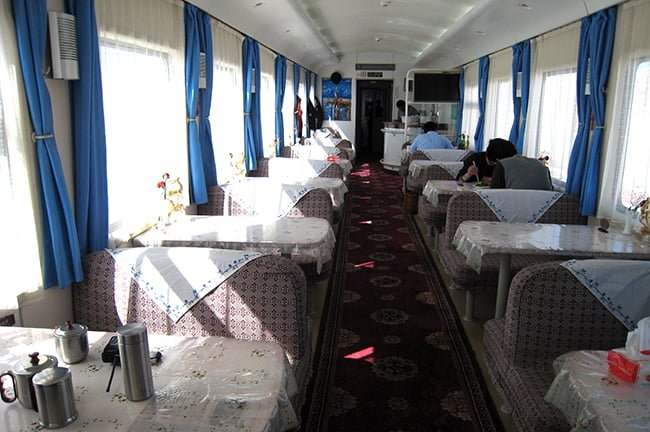
Tourists can order some traditional Chinese home-made dishes
You can get 3 meals and drinks from the dining carriage located in the middle of the train. Usually only Chinese food such as noodles, dishes and soups is available and it costs about 20 CNY/meal and accepts cash payment, Wechat payment and Alipay.
The trolleys loaded with food are served in each compartment sporadically and tourists can buy from the staff of train. Besides, tourists can get free boiled water from hot water dispenser near the sinks.
2. Facilities on the Train
Toilets: The soft sleeper carriage has one western-style toilet and one squat style toilet, while hard sleeper carriage only has two squat style toilets. Toilets are located at the end of each carriage, adjacent to the washbasin, dustbin and hot water dispenser. The toilets will be locked when the train stops. Avoid to use them when the train is about to stop for arriving at a station. The red sign on the toilet door means the toilet is occupied while the green sign means not occupied. Next small but important thing is to have enough tissue or toilet paper. Because it is used fast and one won’t find any replacement if it runs out.
Washbasin: Usually only cold water is available. Tourists need to bring their own towel, wet paper tissue and toilet articles.
Dustbin: There is a big dustbin at the end of the carriage. And you can find small dustbin in each compartment and metal plate on the table along the aisle. A cleaner will sweep the floor and collect luggage from the compartment from time to time. All the waste will be disposed by train staff when arrive at stops along the way.
Hot water dispenser: There are free boiled water all the time. Bring your own water flask and get water when the light on the dispenser turns green.
FAQs:
Q1. Where to recharge your mobile phones and electronic devices? The power plug for chargers are located in the corridors OR under your table in the cabin with the 4 soft sleepers (in between the 2 lower bunks).
Q2. Can tourists have shower in the train? Unfortunately, there is no shower room in the train. Do bring some wet wipes in stores and a small towel. And small but equally important thing is to bring enough toilet/tissue paper.
3. Altitude Change of Xining to Lhasa Train
Xining to Lhasa Railway, measuring 1,956 km, starts from Xining (2,275m) to Lhasa (3,650m). This railway with the highest altitude around the world reaches its highest point at Tanggula Pass (5,072m) and the entire railway line is built over 4500m. It is known that high altitude may trigger physical discomforts such as headache, dizziness and other altitude sickness symptoms. Yet, this specially-built train is equipped with oxygen supply system that will automatically release oxygen into the carriage to minimize altitude sickness when reaches Golmud (2,829m).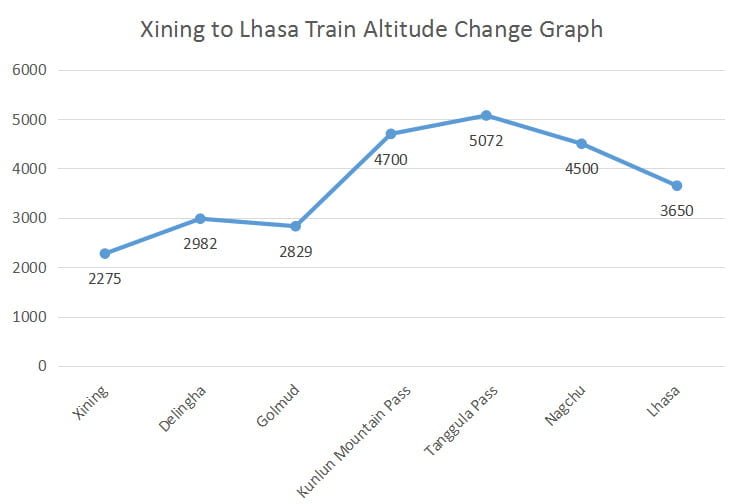
This graph gives you a rough idea of how altitude changes along Xining-Lhasa railway line
4. Oxygen Supply and Altitude Sickness
Sometimes called “mountain sickness”, altitude sickness is a group of symptoms that can strike if you walk or climb to a higher altitude too quickly. Characterized by symptoms such as headache, dizziness, fatigue, nausea, altitude sickness is the biggest concern for travelling to Tibet.
Air-conditioning alone is not sufficient to make a cozy environment on the train to Tibet. The oxygen supply is the key element to ensure passengers’ comfort and safety. There are two oxygen-supply systems on each train. One is used for increasing the oxygen level in the train, by temperature and air pressure controlling systems, when the train enters into the plateau zone. The other is directly used by passengers through an independent port. There are oxygen supply tubes and masks in each cabin for emergencies. Private oxygen masks are provided to every passenger, whatever ticket they have. In sleeping berth cars, you can find outlets on the wall beside the windows, while in seat cars, you can find outlets under your seat.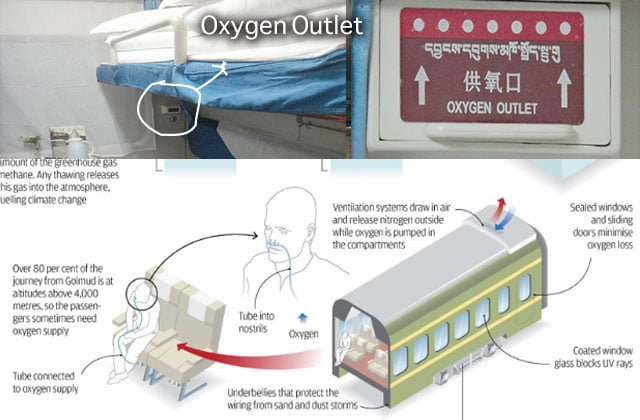
An illustration of how to use oxygen outlet on Qinghai-Tibet train
As the train ascends to Golmud, the oxygen is automatically pumped into the train and tourists can also manually use the oxygen outlet to minimize altitude sickness symptoms such as headache, dizziness, fatigue,nausea,etc. It is advisable to bring altitude sickness medicines to ease the discomfort.
You can drink lots of water, eat light food and take a good rest to prevent high altitude sickness. It is advisable to consult the doctor for altitude sickness medicines weeks pior to the trip.
FAQs:
Q1. How to Get Help on the Train? Some of the staff on the train speak English and they are easy-approaching and hospitable to foreign tourists. If one runs into any trouble, you may ask the head of conductor for help. Most of the passengers may have symptoms of altitude sickness (such as headache, fatigue, difficult sleeping, lack of appetite, etc.) as the train reaches Qinghai-Tibet plateau. Now, you may switch on the oxygen outlet to inhale oxygen to ease the discomfort. If the symptom gets worse, you may find the conductor for help and the doctor on the train will come and give you timely treatment.
Q2. How can we minimize the effect of altitude sickness? The effect of altitude sickness on passengers varies. Yet, to minimize or ease the impact of altitude sickness, one may prepare some altitude sickness tablets before boarding the train and take some when the train climbs to plateau. There is no need to worry too much the altitude sickness, the train is built with oxygen supply system which is easy to use.
Q3. Is smoking allowed in the cabin? Smoking is strictly forbidden in the train as the train is tightly sealed and pressurized and oxygen is pumped into the carriage when the train ascends to extreme altitude.It would be devastating if the train caught fire.
5. Views along Xining-Lhasa Railway
Xining-Lhasa Raiway, the genuine Qinghai-Tibet Railway, is the only rail route from mainland China to Tibet. There are 45 stations along the railway. But Xining-Lhasa Train Z6801 only stops at five of them before reaching Lhasa: Delingha, Golmud, Amdo, Nagchu, and Dumgxung.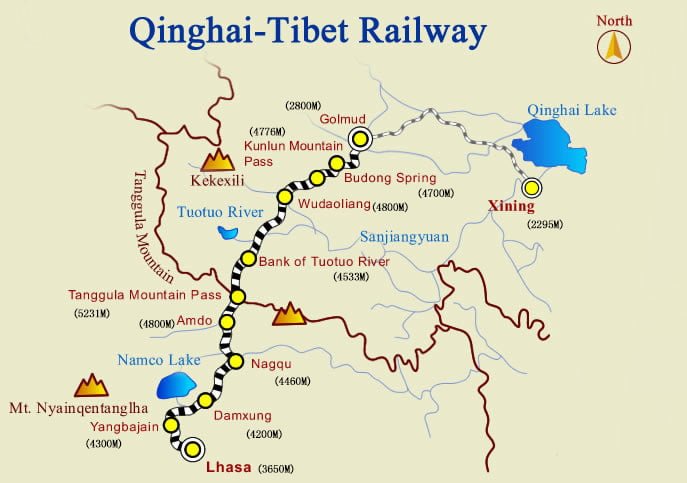
Xining to Lhasa Railway Map
Not only is the Qinghai-Tibet Railway itself considered as a man-made wonder in the transportation field but also the stunning scenery along the rail offers a visual feast for tourists who are heading towards Tibet for travel.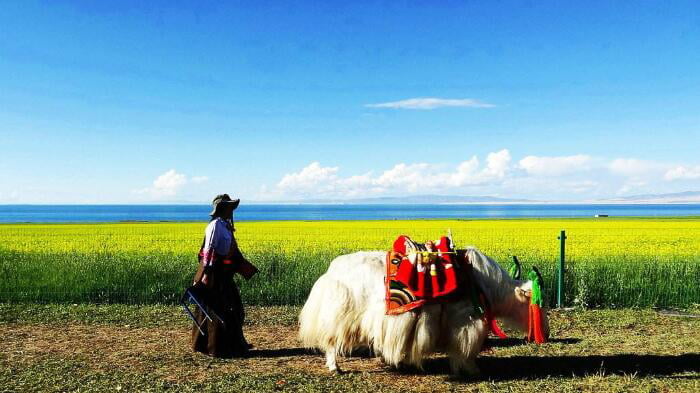
Qinghai Lake has a single colour inclusive of both blue and green as separate shades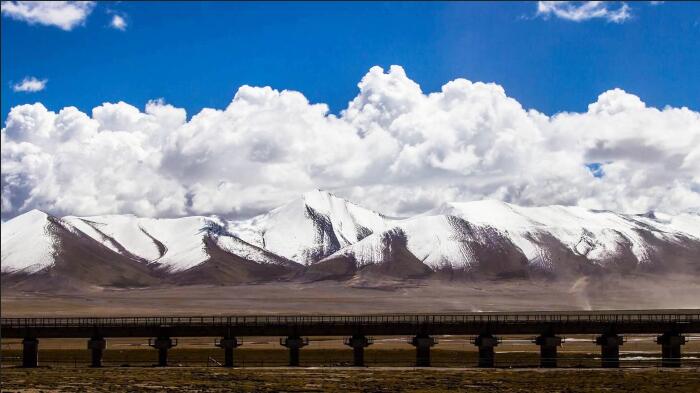
Tanggula Mountains are the geographic headwaters of the Yangtze Rive
The boundless Qiangtang Prairie stretches in Nagchu
How to Get to the Train Stations?
Xining Railway Station
Xining Railway Station is the main railway station serving the city of Xining in Qinghai Province. It is the first station on the Qinghai-Tibet Railway which connects the city with Lhasa in Tibet.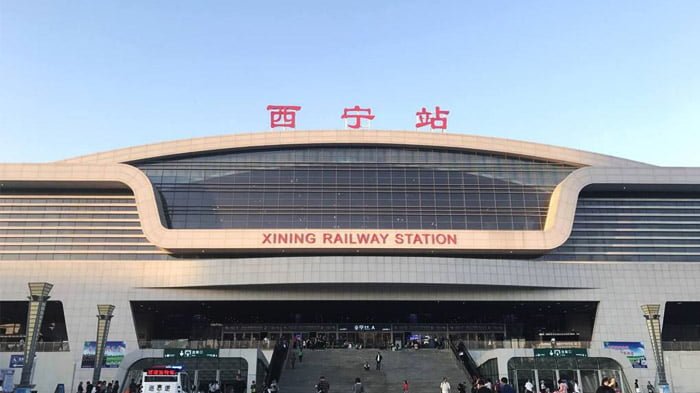
Xining Railway Station
Address: No. 128 of Huzhu Road, Chengdong District, Xining Phone: 86-0971-9510510 Ticket booking hotline:: 12306 Distance from Airport: Appro. 27km Bus to there: No.1, No.3, No.11 etc
Xining Railway Station is around 8km from downtown and 27km from Xining Caojiabao International Airport (XNN). It provides luggage storage service for passengers, it costs 5-10 CNY for each piece, according to the size of your luggage. Even though there is no metro in Xining at present time, it is still convenient for tourists to arrive at Xining Railway Station by bus, taxi or airport shuttle.
From Downtown to Xining Railway Station
Taxi: Taking a taxi from downtown to Xining Railway Station takes around 24 minutes.
Bus: There are around 15 pairs of buses arriving at Xining Railway Station, such as Bus No. 1, 3, 11, etc
From Xining Caojiabao International Airport to Xining Railway Station
Xining Caojiabao International Airport (XNN) is located about 30 kilometers east of downtown Xining and 27km from Xining Railway Station. You can take a taxi or airport shuttle bus to go there.
Taxi: Usually it takes a taxi around 35 minutes from the airport to Xining Railway Station. By taking the Beijing-Tibet Highway G6, the taxi driving time can be shortened to around 25 minutes.
Airport Shuttle – Bayi Line : Price: CNY 21.00/ person Duration: 50 minutes Frequency: Every hour How to go: Get on the shuttle towards Bayi Coach Station and get off at Bayi Coach Station => walk about 440 meters to take Bus No. 105 at Huangzhongqiao Bekou and get off at West of Xining Railway Station Square. The whole ride takes around 1.5 hours.
Lhasa Railway Station
Lhasa Railway Station is the terminal of the Qinghai-Tibet Railway and serves as the central hub and biggest train station in Tibet for its huge transport capacity. Situated in Liuwu New Area of southwest Lhasa at an altitude of 3,641 meters, it is only 8 kilometers to downtown Lhasa, 20 kilometers to southwest of the Potala Palace.
When you arrive in Lhasa by train, our guide will greet you and bring you to start your once-in-a-lifetime trip to explore the mysterious Tibet – the roof of the world.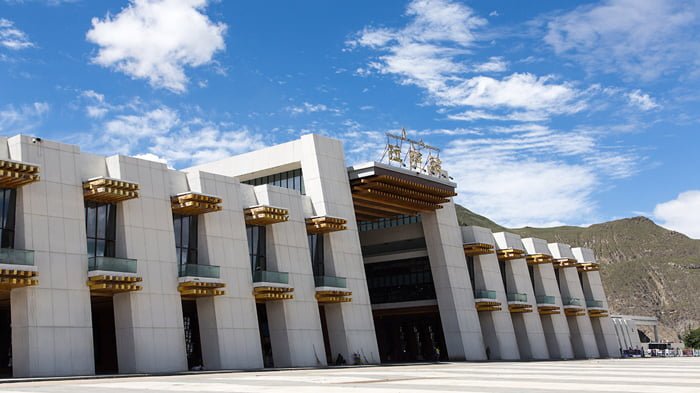
Lhasa Railway Station

